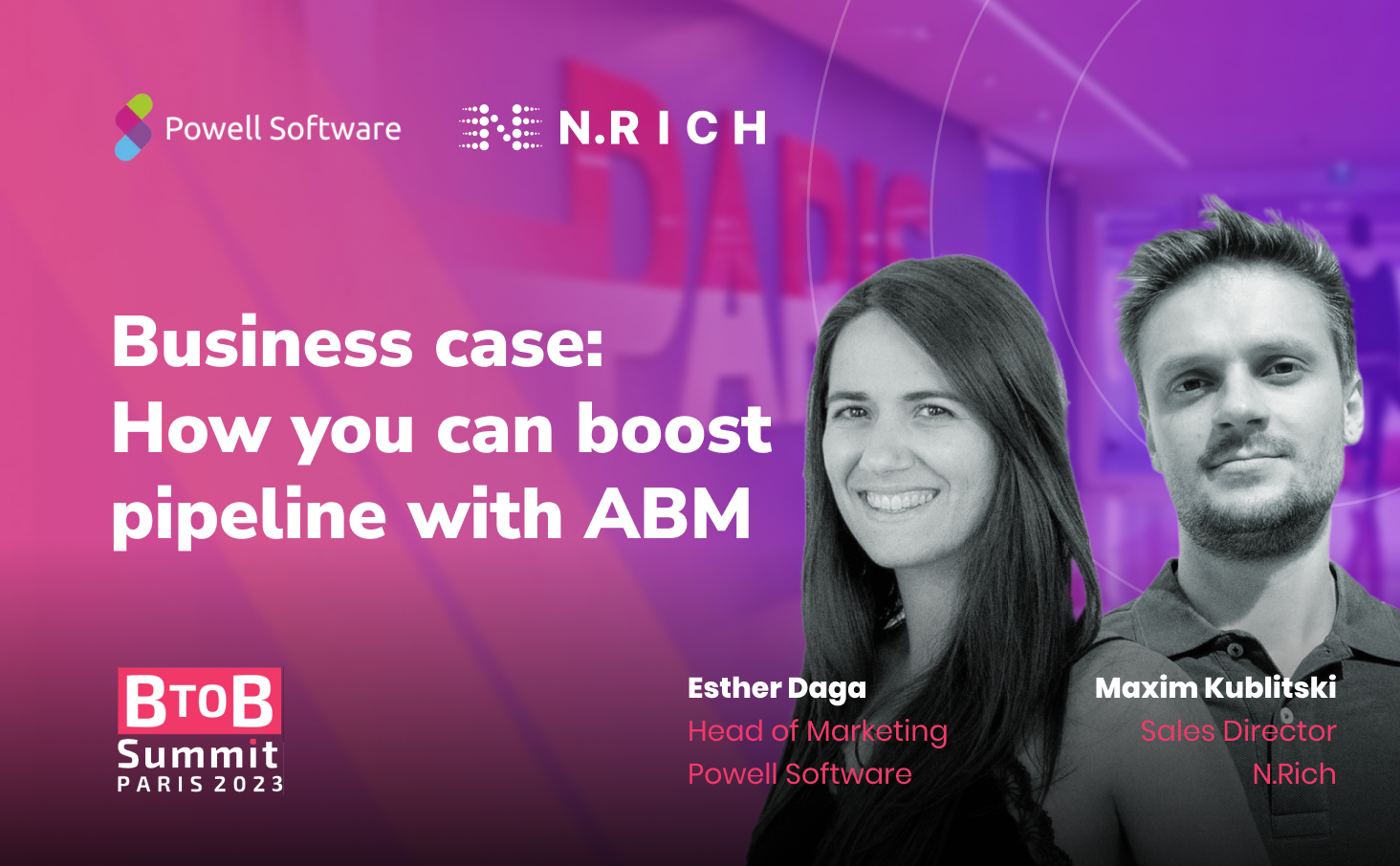
Darya Krakaviak
~2 min
How to Boost Pipeline with ABM
Earlier this June N.Rich together with our customer Powell Software joined the BtoB Leaders Summit in Paris.
Maxim Kublitski, our Sales Director, and our customer Esther Daga, Head of Marketing at Powell Software, discussed what ABM is and explored how ABM platforms like ours could help boost lead quality and conversion rates to increase revenue for your company.
Read further for:
- What are the main challenges ABM can help tackle
- A step-by-step ABM implementation workflow
- ABM helping drive 40% higher conversion rate from MQL to SQL: a case study
In this article, we will break down the presentation they made. Please see the full video here.
Status Quo: Wrestling with The Pressure to Perform
In March of 2023, the Gartner CMO Survey revealed that a whopping 59% of marketing leaders are grappling with increased pressure from CEOs to prove the impact of their marketing efforts on revenue.
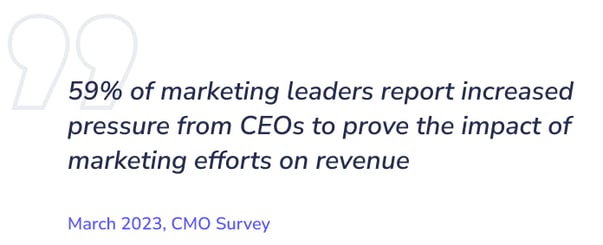 What's the cause of that?
What's the cause of that?
It seems to be rooted in a shifting landscape that's seen the role of marketing evolve from simply creating brand awareness to being a key driver of sales growth and customer engagement.
Here are the challenges CMOs are grappling with in 2023:
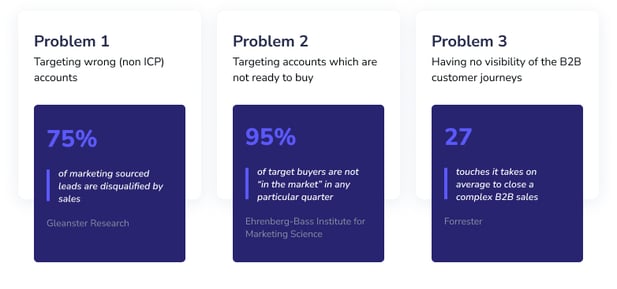 For the modern CMOs, it’s not about paddling harder anymore – it's about navigating smarter.
For the modern CMOs, it’s not about paddling harder anymore – it's about navigating smarter.
The solution that allows them to target the right accounts, understand their readiness to buy, and have a clear view of the B2B customer journey is Account-Based Marketing (ABM). Let’s review this approach in more detail further in the article.
Unraveling the Complexities of the B2B Customer Journey in 2023
First off, it’s important to realise the scale of complexity of a regular B2B customer journey. It is not linear. It's more like a labyrinth with numerous points of entry and exit – the below is a great illustration of that:
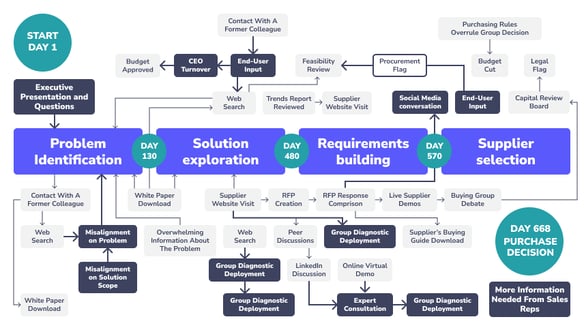
Source: Gartner
Each interaction a prospect has with your brand, whether it's reading a blog post, downloading a whitepaper, or attending a webinar, brings them one step closer to becoming a customer. However, these interactions must be orchestrated carefully to ensure that they align with the prospect's readiness to buy and where they are in the buying journey.
Moreover, these multi-touch journeys require extensive resources. They necessitate a robust tech stack, the production of quality content, accurate tracking and measurement systems, and most importantly, a team capable of executing a cohesive and targeted strategy.
This is where account-based GTM (Go-To-Market) strategies come into play. They help reinvent the way B2B marketing is done, and the results can be truly transformative.
Diving into Account-based GTM Strategies
When it comes to tackling the intricacies of the modern B2B customer journey, unlike a lot of other Marketing tactics and strategies, account-based ones are focused and precise. They're about identifying key accounts, understanding their unique needs and challenges, and then crafting personalized campaigns to engage them effectively.
Here is a simple yet effective ABM workflow that you can start implementing right now – learn more in this article.
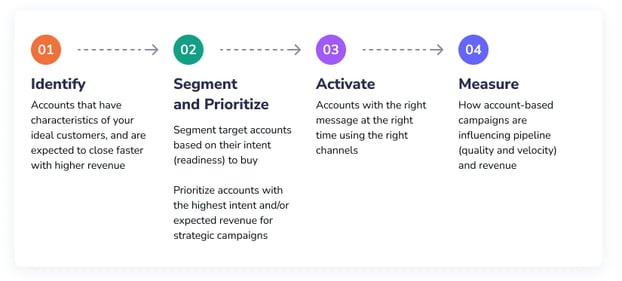
Who ABM is For: The Key Beneficiaries
Account-Based Marketing is not a one-size-fits-all solution.
The potential benefits of ABM largely depend on specific characteristics of your business model, market conditions, and the nature of your products or services.
Let's delve into who stands to gain the most from implementing an ABM strategy.
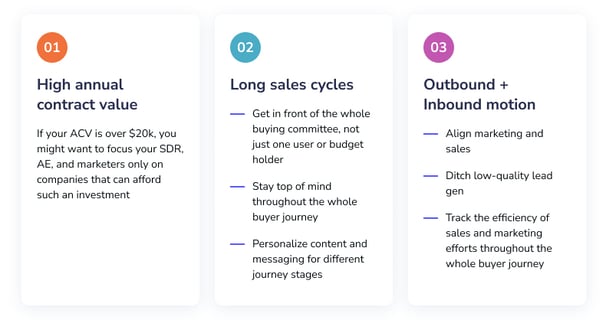
High Annual Contract Value: The Big Fish
If your Annual Contract Value (ACV) exceeds $20,000, ABM could boost your business.
When dealing with high-value contracts, it's crucial to focus your Sales Development Reps (SDRs), Account Executives (AEs), and marketing professionals on companies capable of such substantial investments.
By honing in on these 'big fish,' you can increase the chances of closing significant deals and boost your ROI.
Long Sales Cycles: The Marathon Runners
ABM can be particularly beneficial for businesses with long sales cycles.
With multiple decision-makers involved and the buying journey often lasting months, it's imperative to keep your company front and center throughout the entire process. Here’s how ABM could help with that:
- Engage the whole buying committee, not just one user or budget holder.
- Remain top of mind throughout the entire buyer's journey.
- Personalise content and messaging for different journey stages.
Outbound + Inbound Motion: The Dual Track
ABM can excel in setups where businesses are operating with both outbound and inbound sales motions.
By adopting an ABM strategy, you can:
- Align marketing and sales towards a common set of accounts.
- Transition from low-quality lead generation to highly targeted account engagement.
- Efficiently track the influence of sales and marketing efforts throughout the entire buyer journey.
In conclusion, ABM can be a powerful tool for businesses operating with high ACVs, long sales cycles, or a mix of outbound and inbound sales motions.
As with any strategic decision though, consider your unique situation and requirements before jumping on the ABM bandwagon.
Why Companies Are Slow to Implement Account-Based GTM Strategies
Despite the well-documented benefits of Account-Based Marketing and being fit for it, many companies are hesitant to make the leap.
Let's explore the main reasons for such reluctance.
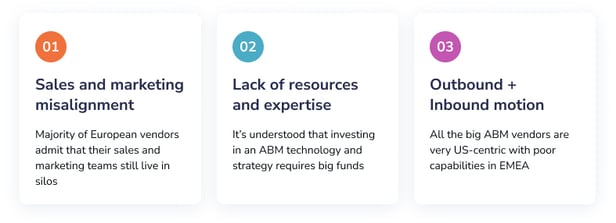
Sales and Marketing Misalignment: The Silo Syndrome
Surprisingly, the majority of European vendors report that their sales and marketing teams continue to operate in silos.
This separation hampers the alignment required for successful ABM, with disjointed efforts leading to wasted resources and missed opportunities.
True ABM requires seamless integration of these two functions, focusing on shared objectives and coordinated strategies.
Lack of Resources and Expertise: The Investment Dilemma
Investing in ABM requires not only a significant financial commitment but also a commitment of time and human resources to effectively implement and manage the strategy.
Businesses may be deterred by the perceived cost and expertise required for a full-scale ABM rollout, with many unsure if they can spare the necessary resources or justify the expense.
The key is to remember that while the initial investment may be significant, the potential returns – in terms of improved conversion rates, higher-value contracts, and enhanced customer relationships – will be worth it.
Limited Data and Targeting Outside North America: The Geo-Limitation
Another hurdle is the geographical focus of many major ABM vendors.
While they excel in their data and targeting capabilities within the US, their services are often less comprehensive in other regions, particularly EMEA (Europe, Middle East, and Africa).
This can limit the effectiveness of ABM for companies operating outside North America, as they may struggle to find a service provider that can deliver the granular, account-level data required for effective ABM in their region.
Despite the above challenges, the benefits of ABM can outweigh the obstacles for many companies. It's a question of careful planning, wise resource allocation, and finding the right partners to support your ABM journey.
Powell Software Case Study: Boosting the Pipeline with ABM
Powell Software, a SaaS company headquartered in Paris, France, is known for developing digital workplace solutions that enhance the employee experience and empower companies to define their own "future of work."
Yet, like many businesses, Powell Software grappled with its marketing strategy, seeking ways to increase lead quality and optimize its advertising efforts, and gave ABM a try.
Powell Software: The Challenges Before ABM
Prior to their ABM journey, Powell Software was investing heavily in Google Ads (Search & Display Network) and LinkedIn Ads. However, the outcomes didn't match their aspirations.
The core challenges they were grappling with include:
Low-Quality Marketing Leads and Subpar Conversion Rates
Their key objective was to maximize lead generation, which led them to guide their ads predominantly to a demo request landing page. They quickly realised that quantity didn’t equate to quality though.
Despite generating a significant number of leads each month, they found these leads were often unqualified or poorly suited to the sales team's needs.
Lack of Insights into the Buyer Journey
A significant portion of marketing leads came from irrelevant sources, such as small companies, individuals, or even fake contacts.
This resulted in the Sales Development Representatives (SDRs) having little interest in prioritizing these leads, as they lacked valuable insights into the buyer's journey and readiness to purchase.
Need to Target Different Verticals
The Powell Software team had a wealth of high-quality content, including industry-specific success stories and blog posts.
The challenge lay in disseminating this content to the right people at the right time.
While LinkedIn offered segmentation based on verticals and job titles, it couldn’t provide insights on buyer intent. Besides, it was expensive and not scalable enough for their needs.
Powell Software's ABM Triumph: The Results
This is why Powell Software ventured into ABM.
The results have been impressive indeed.
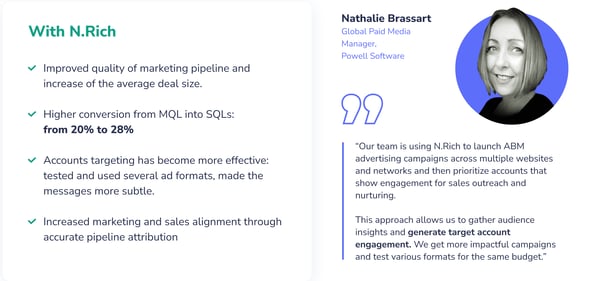
Boosted Lead Quality and Conversion Rate
ABM had a positive effect on the quality of the marketing pipeline and led to an increase in the average deal size. The conversion rate from Marketing Qualified Leads (MQLs) to Sales Qualified Leads (SQLs) saw a remarkable rise, jumping from 20% to 28%!
Improved Sales & Marketing Alignment
By providing SDRs with actionable insights on target accounts showing strong intent towards their services, Powell Software effectively bridged the gap between their sales and marketing teams.
Enhanced LinkedIn Ads Performance
Combining LinkedIn's targeting capabilities with N.Rich’s intent data, the company enhanced the efficacy of its ads, improving its account targeting and refining its messaging across various ad formats.
Why did Powell Software Select N.Rich specifically though?
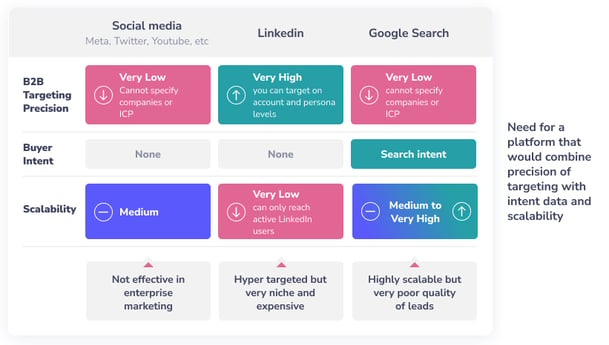
When selecting an ABM platform, Powell Software considered the following factors:
ICP, Intent Data, ABM Targeting, and Attribution in One Platform
N.Rich provided Powell Software with the ability to manage their entire ABM workflow on a single platform.
It offered features for identifying their Ideal Customer Profile (ICP), ABM targeting, and intent data, along with attribution capabilities, all at a very affordable cost.
High-Precision Scalable Advertising at Low Rates
N.Rich offered a solution that was 40 times more scalable than LinkedIn Ads, with an average cost of engagement 4-5 times lower than LinkedIn. This was optimized with intent data and dynamic scoring.
Quality European Data
As the only Europe-native ABM provider, N.Rich was able to offer high-quality data, proprietary technology, and local expertise in Europe, along with multilingual support for intent data.
This case study serves as a testament to the power of ABM in overcoming marketing challenges, boosting lead quality, and improving conversion rates.
From “Why ABM?” to “Why not ABM?”
The journey of Powell Software with Account-Based Marketing illuminates the path for other businesses striving to enhance their marketing effectiveness.
It's a testament to the significant potential that ABM holds – from boosting lead quality to optimizing advertising costs and enhancing alignment between sales and marketing teams.
The question businesses need to ask isn't "Why ABM?" but rather – "Why not ABM?"
Yet, the transition to ABM is not without its challenges. The move requires the breakdown of internal silos, the investment in necessary resources, and overcoming geographical limitations in data and targeting. As demonstrated by Powell Software though, these hurdles can be overcome with the right partner.
The future of B2B marketing is here, and it's account-based – so why not ABM?